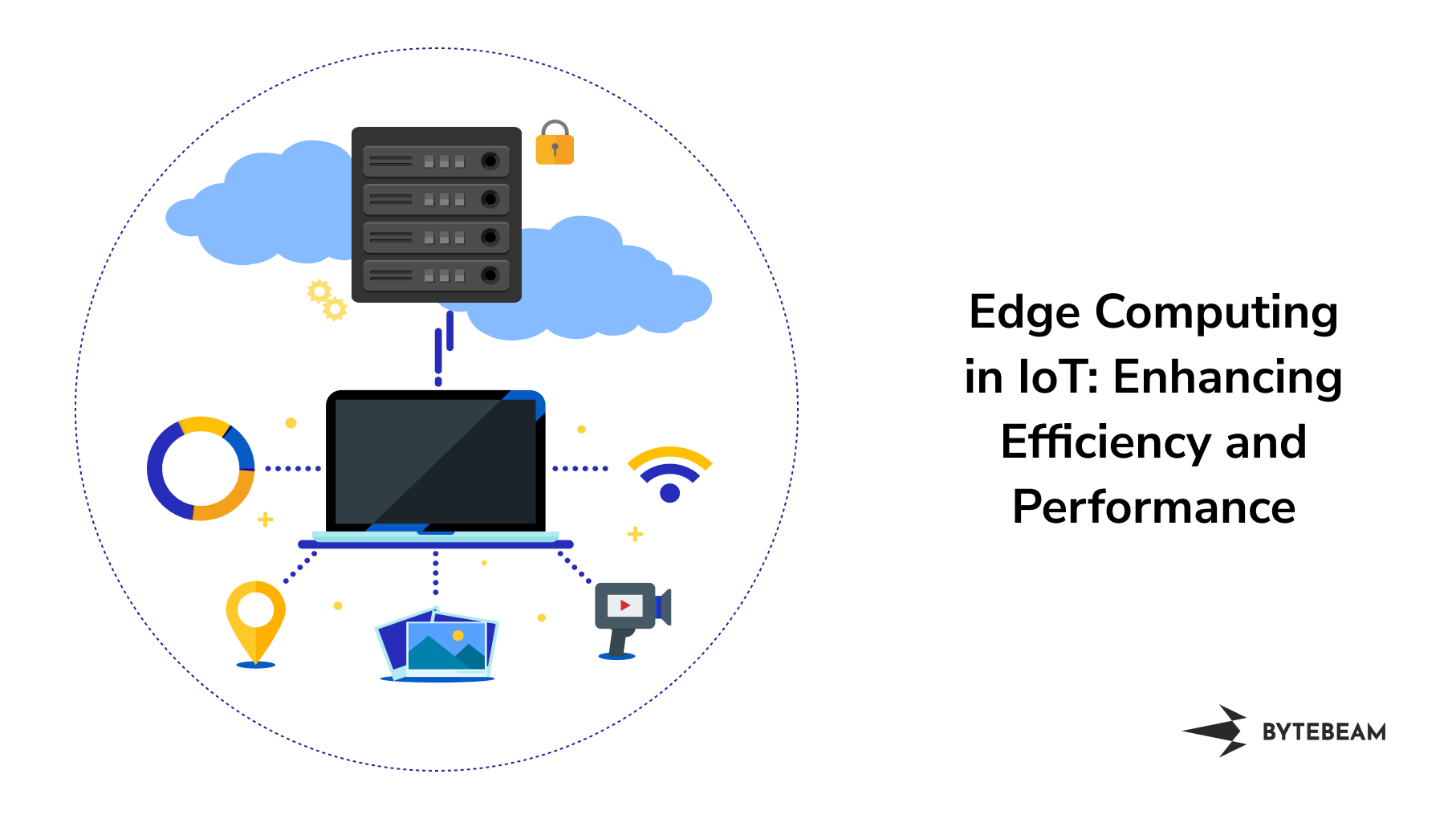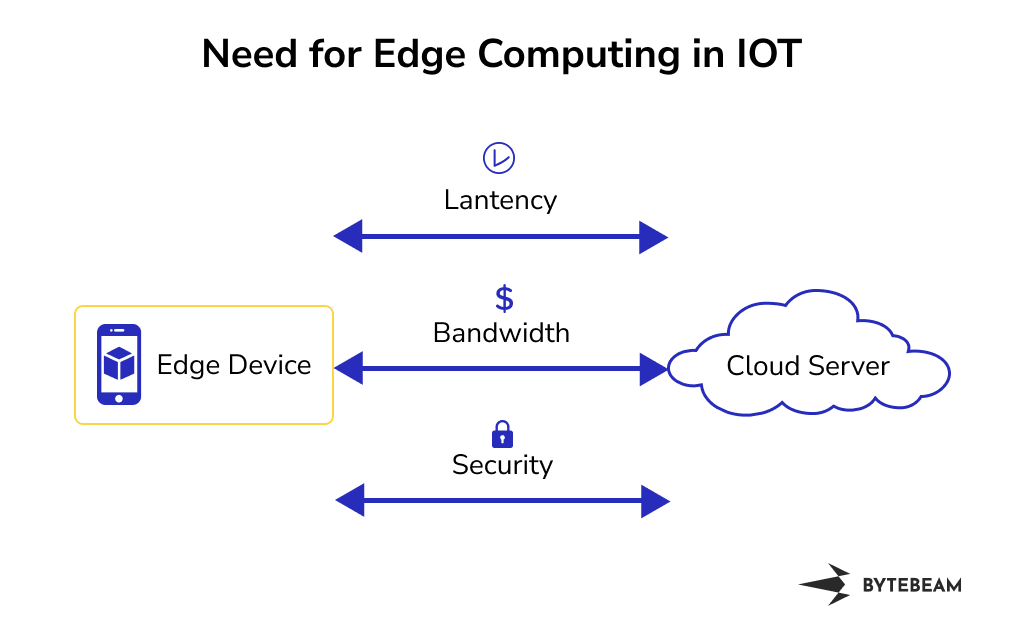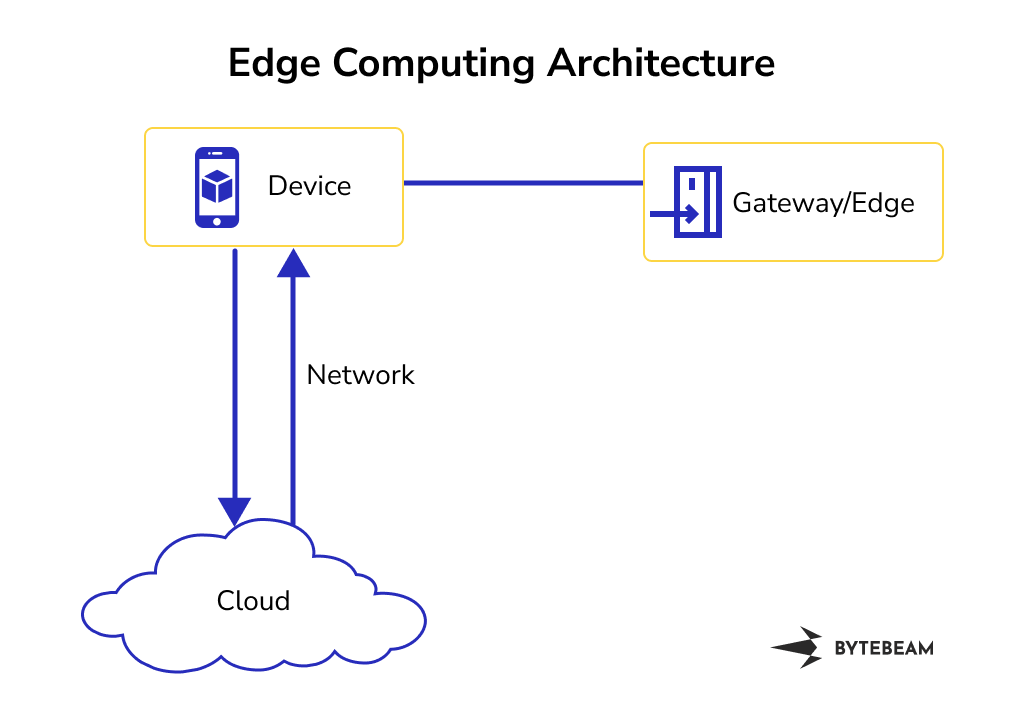Edge Computing in IoT: Enhancing Efficiency and Performance

Edge computing in IoT is one of the biggest achievements of technological advancements in our time. As IoT can potentially address some of the most pressing challenges of our time, including food and water scarcity, climate change, and global health crises, the integration of edge computing amplifies its impact manifold.
What to expect: In this guide, we will take a look at edge computing and do a deep dive into the nitty-gritty of the technology.
The Need for Edge Computing in IoT
Each IoT device generates a vast amount of data, and with billions of such devices connected worldwide, the amount of data generated is immense. This data needs to be processed, analyzed, and acted upon in real-time or near-real-time to extract valuable insights and enable timely decision-making.

For example, sensors on a manufacturing line might detect a fault in a product, and immediate action is required to remove the defective product from the line.
The traditional approach of sending all this data to the cloud for processing is not always feasible due to several reasons:
- Latency: It takes time to send data to the cloud and then get the processed data back. This delay is not feasible for applications that need instant responses.
- Bandwidth: Transmitting huge amounts of data needs a lot of bandwidth, which can be expensive and sometimes not even available.
- Security: Sending data over the internet has its risks, like unauthorized access.
Edge computing brings the computation closer to where the data is generated, either on local servers or even the devices themselves. This has some great benefits:
- Reduced Latency: Processing data locally means no more waiting for data to travel to the cloud and back. This enables real-time decision-making.
- Reduced Bandwidth: Less data traveling over the internet means saving on bandwidth costs and less network congestion.
- Increased Security: Processing sensitive data locally means it doesn't have to travel over the internet, reducing the risk of data breaches.
So, by using edge computing in IoT, organizations can process data efficiently, make decisions timely, and save costs. It's a win-win-win situation, which is why edge computing is such an important part of the IoT ecosystem.
What is Edge Computing?
Edge computing is a way of processing data closer to where it's generated, instead of sending it all the way to a far-away cloud server. Imagine you have a smartphone. With edge computing, the data generated by your phone could be processed right on your phone or on a nearby server, instead of being sent all the way to a distant cloud server.
This approach has several benefits, like faster processing times, less data traveling over the internet, and increased security.
Now, let's talk about the key components of edge computing:
- Edge Devices: These are the devices that generate or collect data. It could be anything from a smartphone, a sensor, a car, or even a refrigerator.
- Edge Nodes or Edge Gateways: These are the devices or servers that are located closer to the edge devices. They are responsible for processing the data locally or sending it to the cloud if necessary. Think of them as the middleman between the edge devices and the cloud.
- Network Connectivity: This is the connection between the edge devices, edge nodes, and the cloud. It can be wired or wireless.
- Cloud: This is where the data is sent if it cannot be processed locally, or if it needs to be stored for later use.
So, in a nutshell, edge computing involves edge devices generating data, edge nodes processing that data locally, and then, if necessary, sending it to the cloud for further processing or storage. And all of this is connected by network connectivity.
Key Features of Edge Computing
Edge computing has a few key features that make it really useful, especially in the context of IoT. Let's go through them:
- Local Data Processing: This is one of the main features of edge computing. Instead of sending all the data collected by IoT devices to a far-away cloud server for processing, the data is processed locally, either on the device itself or on a nearby edge node. This means faster processing times and less data traveling over the internet.
- Reduced Latency: Latency is the time it takes for data to travel from one point to another. Because edge computing processes data locally, it greatly reduces the time it takes to get a response. This is super important for applications that need real-time or near-real-time responses, like self-driving cars or industrial machines.
- Bandwidth Savings: Transmitting data over the internet requires bandwidth, and with the huge amounts of data generated by IoT devices, this can be quite costly. By processing data locally and only sending the necessary data to the cloud, edge computing helps to save on bandwidth costs.
- Increased Security: Processing data locally means less data traveling over the internet, which reduces the risk of data interception and unauthorized access. This is especially important for sensitive or critical data.
- Scalability: As the number of IoT devices and the amount of data they generate increases, it becomes more and more challenging to manage and process all this data in the cloud. Edge computing helps to address this by distributing the data processing load across the edge nodes and the cloud.
These features make edge computing a great solution for managing and processing the huge amounts of data generated by IoT devices.
Edge Computing Architecture
The edge computing architecture is similar to most common IoT architectures.

The architecture of edge computing can be divided into several layers, each with its own set of components. Let's go through them:
Device Layer
This is the bottom-most layer, and it consists of all the IoT devices and sensors that collect data. These devices can be anything from smartphones, wearable devices, industrial machines, or even cars. Some of these devices may have the capability to do some basic data processing, while others just collect and send data.
Edge Layer
This layer consists of the edge nodes or edge gateways that are located closer to the IoT devices. These edge nodes are responsible for processing the data locally, either completely or partially. The edge layer can include various types of devices, such as routers, gateways, or even small-scale data centers. These devices typically have more processing power and storage capacity than the IoT devices in the device layer.
Network Layer
This layer is responsible for the communication between the devices, edge nodes, and the cloud. It includes all the network components required for data transmission, such as switches, routers, and network connections (wired or wireless).
Cloud Layer
This is the top-most layer, and it consists of the cloud servers and data centers where the data can be further processed, analyzed, or stored. The cloud layer typically has much more processing power and storage capacity than the edge nodes or IoT devices.
So, in a typical edge computing architecture, the data flows from the device layer, through the edge layer and the network layer, and finally to the cloud layer. The edge layer processes the data locally, reducing the amount of data that needs to be sent to the cloud, and therefore reducing latency, bandwidth consumption, and increasing security.
Each of these layers plays a crucial role in the overall functioning of an edge computing system, and together they enable the efficient processing and management of the huge amounts of data generated by IoT devices.
Role of Artificial Intelligence and Machine Learning at the Edge
AI (Artificial Intelligence) and ML (Machine Learning) algorithms are incredibly useful for analyzing data and making decisions. And they come in especially handy when edge computing is a necessity.
When data is processed locally at the edge, there are several decisions to be made. And those decisions require some computation. AI and ML algorithms can make these decisions based on previously collected data. For example, an AI algorithm on a self-driving car can analyze images from the car's cameras in real-time to identify obstacles and make decisions on how to navigate.
Post-analysis actions can also be taken with the help of AI algorithms, such as identifying a manufacturing defect and stopping the production line or removing the product.
If necessary, the processed data or the results of the analysis can be sent to the cloud for further processing, analysis, or storage. For example, the edge node might send the analysis results to the cloud for long-term storage or for further analysis with more powerful computing resources. This decision can also be made at the edge with ML algorithms.
By deploying AI and ML algorithms at the edge, we can analyze data and make decisions in real-time, without the need to send all the data to the cloud.
Security and Privacy in Edge Computing
Let's talk about some of the security and privacy challenges in edge computing:
- Data Security: Since edge computing involves processing data at the edge nodes or devices, there is a risk of unauthorized access to the data. Edge nodes may not have the same level of security measures as centralized cloud servers.
- Device Security: IoT devices at the edge can be vulnerable to physical attacks, tampering, or unauthorized access. Additionally, these devices may have limited computational resources, which makes it challenging to implement robust security measures.
- Data Transmission: The transmission of data between the edge devices, edge nodes, and the cloud could be intercepted, and sensitive data could be exposed.
- Data Privacy: Processing data locally on edge nodes or devices can lead to privacy concerns, especially if the data is sensitive or personally identifiable.
- Scalability of Security Measures: As the number of devices and edge nodes increases, it becomes challenging to manage and update the security measures across all devices and nodes.
Now, let's talk about some solutions and best practices to address these challenges:
- Data Encryption: Encrypting the data before transmitting it between the edge devices, edge nodes, and the cloud can help prevent unauthorized access to the data during transmission.
- Secure Communication Protocols: Using secure communication protocols like TLS (Transport Layer Security) can help ensure the integrity and confidentiality of the data during transmission.
- Authentication and Authorization: Implementing strong authentication and authorization mechanisms can help ensure that only authorized users and devices can access the data or the edge nodes.
- Regular Updates and Patching: Regularly updating the software, firmware, and security measures on edge devices and nodes can help protect against known vulnerabilities.
- Physical Security: Implementing physical security measures, like secure access controls or tamper-proof hardware, can help protect edge devices and nodes from physical attacks or tampering.
- Data Anonymization: Anonymizing the data before processing it on the edge nodes or devices can help address privacy concerns.
- Firewalls and Intrusion Detection Systems: Implementing firewalls and intrusion detection systems on the edge nodes can help protect against unauthorized access or attacks.
Remember, it is essential to take a holistic approach to security and consider all aspects of the edge computing system, from the devices to the network and the cloud. A combination of these techniques and best practices can help address the security and privacy challenges in edge computing.
Edge and Cloud Integration
While edge computing reduces the strain on servers and the need for sending all the data back, it works best when it is fully integrated with the cloud. Integrating edge computing with cloud computing is crucial for several reasons:
Data Management: While edge computing can process data at the source and reduce the amount of data that needs to be sent to the cloud, there is still a need for centralized data management, storage, and analysis. The cloud provides a centralized location for storing and analyzing large amounts of data collected from various edge devices.
Computational Power: Edge devices have limited computational power. While they can perform basic data processing and real-time analysis, complex computations and analyses may still need to be performed in the cloud, which has significantly more computational resources.
Scalability: Cloud computing provides virtually unlimited scalability, which is necessary for applications that need to process large amounts of data or serve a large number of users. Edge computing alone may not be able to handle such loads.
Flexibility: Integrating edge and cloud computing allows for greater flexibility in how applications are developed, deployed, and managed. Some parts of the application can be deployed at the edge for real-time processing, while others can be deployed in the cloud for centralized processing and analysis.
Cost-Efficiency: Processing data at the edge reduces the amount of data that needs to be transmitted to the cloud, which can result in cost savings in terms of data transmission and storage. However, the cloud can still be used for long-term storage, complex computations, and centralized management, which can be more cost-effective than doing everything at the edge.
Use Cases and Applications
Edge computing in IoT has a wide range of real-world applications that enhance efficiency and performance.
Smart Cities
Edge computing can be used in smart cities for real-time processing and analysis of data from various sensors and devices. For example, traffic data from cameras and sensors can be processed at the edge to manage traffic lights and reduce congestion. Edge computing can also be used for real-time monitoring and control of public utilities, such as water and electricity.
Example: In Barcelona, edge computing is used to manage traffic and public transportation in real time, which has resulted in a reduction in traffic congestion.
Industrial IoT
In industrial IoT, edge computing can be used for real-time monitoring and control of machines and processes. This can help in reducing downtime, optimizing production, and ensuring safety.
Example: GE's Predix platform uses edge computing to analyze data from industrial machines in real time, which has resulted in improvement in asset performance.
Healthcare
Edge computing can be used in healthcare for real-time monitoring and analysis of patients' data. This can help in early detection of health issues, remote monitoring of patients, and personalized treatment plans.
Example: Philips' eICU program uses edge computing to monitor patients' data in real-time, which has resulted in a reduction in mortality and the length of hospital stay.
Retail
In retail, edge computing can be used for real-time analysis of data from cameras and sensors to optimize store layout, manage inventory, and enhance the customer experience.
Example: Walmart uses edge computing to analyze data from its stores in real-time, which has resulted in increased sales and a reduction in inventory costs.
Autonomous Vehicles
Edge computing can be used in autonomous vehicles for real-time processing and analysis of data from cameras, sensors, and other devices. This is crucial for the safe and efficient operation of autonomous vehicles.
Example: Tesla's Autopilot uses edge computing to process data from cameras and sensors in real-time, which enables the car to make split-second decisions and navigate safely.
Agriculture
In agriculture, edge computing can be used for real-time monitoring and analysis of data from various sensors and devices, such as soil sensors, weather stations, and drones. This can help in optimizing irrigation, monitoring crop health, and maximizing yield.
Example: John Deere uses edge computing to analyze data from its tractors and other equipment in real-time, which has resulted in increased crop yield and reduction in fuel consumption.
Edge computing enhances efficiency and performance in these applications by enabling real-time processing and analysis of data at the source. This reduces the need for data transmission to the cloud, which can result in cost savings, reduced latency, and improved performance. Additionally, edge computing can enable more personalized and context-aware applications, which can result in a better user experience.
Challenges in implementation
While edge computing can be beneficial for organizations overall, there can be several challenges when it comes to implementing edge computing in IoT:
- Hardware Limitations: Edge devices often have limited computational power, memory, and storage, which can be a challenge for running complex applications or processing large amounts of data.
- Network Connectivity: Edge devices may have intermittent or low-bandwidth network connectivity, which can be a challenge for applications that require real-time communication or data synchronization with the cloud or other devices.
- Security and Privacy: Edge devices may be more vulnerable to physical attacks or unauthorized access compared to cloud data centers. Additionally, processing sensitive data at the edge raises privacy concerns that need to be addressed.
- Data Management: Managing data at the edge can be challenging due to the distributed nature of edge devices, intermittent network connectivity, and limited storage capacity.
- Interoperability: There are various types of edge devices, operating systems, and communication protocols, which can make it challenging to develop and deploy applications that work seamlessly across different devices and platforms.
- Scalability: Scaling applications at the edge can be challenging due to the hardware limitations of edge devices and the need for real-time communication and data synchronization.
- Resource Management: Efficiently managing the computational, memory, and storage resources of edge devices is crucial for optimizing the performance and cost of edge applications.
- Deployment and Management: Deploying and managing applications at the edge can be more complex compared to the cloud due to the distributed nature of edge devices, network connectivity challenges, and the need for real-time communication and data synchronization.
Implementing edge computing in IoT comes with several challenges. However, future trends and developments, such as 5G connectivity, AI and machine learning at the edge, serverless edge computing, fog computing, blockchain, standardization, and real-time analytics, will help address these challenges and enable more advanced and efficient edge applications.
Final thoughts
The rise of the Internet of Things (IoT) has brought forth a new set of challenges related to data processing, latency, bandwidth, security, and privacy. Edge computing has emerged as a pivotal solution to address these challenges, enhancing the efficiency and performance of IoT applications. By processing data closer to its source, edge computing reduces latency, optimizes bandwidth, and enables real-time decision-making.
As we move towards a more connected world, the role of edge computing in IoT will become increasingly crucial. From smart cities and autonomous vehicles to industrial automation and healthcare, edge computing will play a vital role in enhancing the efficiency and performance of various applications. By understanding the key concepts, architecture, and best practices of edge computing, organizations, and developers can harness its full potential to build innovative and efficient IoT solutions.
If you would like to know more about how you can harness edge computing in your projects, feel free to reach out to us.

